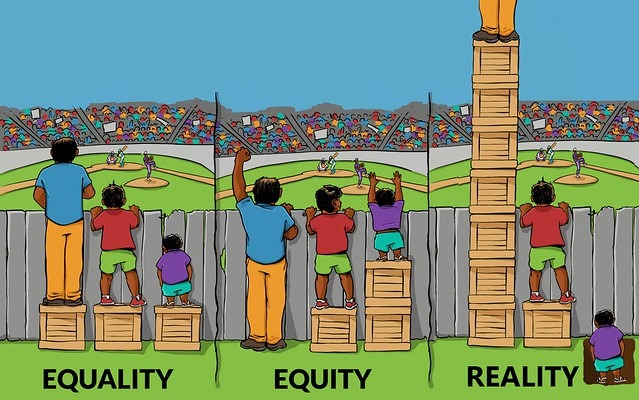We are re-launching during August, with some exciting material here and on our social media channels. Watch for more information, and visit our YouTube channel.
Beyond Equal Education: Why Equity Is the Key to Student Success
6/4/20243 min read


In education, we often hear, "Every child deserves an equal education." It's a noble sentiment, but does equal mean fair? Let's use a popular image to explain the current situation in education.
The School Fence: Barriers to Learning
Picture students trying to watch a baseball game over a tall fence. This fence? It represents barriers to learning—understanding complex texts, mastering algebra, or engaging in class discussions. Some students easily peer over, while others see nothing but wood. As educators, we must ensure every student "sees the game"—accessing and engaging with the curriculum entirely.
Equality: Same Resources, Unequal Learning
The image's first panel, "Equality," shows people of varying heights, each given one box to stand on. In education, this is our traditional model:
Every student gets the same textbook
All face the same homework load
Each has an identical school day
Seems fair, right? Not quite. Just as one box lets only the tallest person enjoy the game; this "equal" approach mainly benefits students already advantaged—those with educated parents, stable homes, or prior academic success. Others might make some progress (glimpse part of the game), while many gain nothing, remaining utterly disengaged.
This equality model assumes all students start at the same level and learn identically. But in reality, learners have diverse backgrounds, abilities, and needs. Dyslexic students struggle with standard texts. Children in poverty may lack quiet study spaces. English language learners grapple with dual comprehension tasks. One-size-fits-all? It often fits few.
Equity: Tailored Support for Universal Success
Enter the "Equity" panel. Here, boxes are distributed based on need:
The tall adult needs none
One child gets one box
The shortest receives two, allowing all to watch comfortably
This mirrors equitable education—where resources match individual student needs:
Dyslexic learners get audiobooks or text-to-speech tools
Students lacking home internet receive hotspots
English learners access bilingual materials
Those behind in math get extra tutoring sessions
Equity recognizes our students' uniqueness. It's not about lowering standards but providing diverse pathways to meet them. A child in foster care bouncing between homes might need more emotional support to focus academically. A gifted student requires challenging projects to stay engaged.
By differentiating instruction, modified assessments, or targeted interventions, we give each student what they need to "see over the fence"—to genuinely access, engage with, and master the curriculum.
Reality: Education's Complex Landscape
But the image's "Reality" panel reminds us that in actual classrooms, achieving equity gets messy. It shows someone teetering on many boxes, seeing better than anyone, while another stays groundbound.
This reflects education's complex realities:
Some students accumulate advantages—enrolling in every AP class, affording private tutors, and leveraging connections for elite colleges.
Others, despite our best efforts, still struggle—facing systemic racism, severe learning disabilities, or the effects of generational poverty.
This panel humbles us as educators. Even with good intentions, some of our equity attempts might miss the mark:
A reading app helps many dyslexic students but not those also dealing with ADHD.
Afternoon tutoring works for some, but not for teens with after-school jobs.
Our celebrated bilingual program serves Spanish speakers well, but what about our growing Somali population?
Moreover, new disparities can emerge. As we offer more AP courses, do they become enclaves for already-advantaged students? When we embrace project-based learning, do some parents "over-help", inflating their student's achievements?
The Quest for Educational Equity
Yet, this messy reality isn't cause for defeat—it's a call to innovative action. Accurate educational equity is a continual journey:
Assess Individually: Regularly audit each student's needs. Tools like universal screening, diagnostic assessments, and student interviews help.
Diversify Approaches: Offer varied supports—assistive tech, flexible scheduling, and culturally responsive texts. What fails for one student might be another's breakthrough.
Empower Students: Teach self-advocacy. Help students articulate their needs and suggest solutions. They often have the best insights into their learning barriers.
Fight Systemic Issues: Educational equity isn't just in-class tactics. It means confronting more significant issues—school funding disparities, discipline biases, and curriculum gaps. Advocate at district and policy levels.
Constantly Adjust: Today's solution might be tomorrow's problem. Stay vigilant. Does tracking help struggling readers or isolate them? Do maker spaces engage all or mainly affluent, tech-savvy kids?
Every Classroom, A Baseball Field
So, look at your classroom through this image's lens. Some students effortlessly engage with your content (peering over the fence). Others participate with standard support (standing on one box). But who's still struggling, staring at wooden planks?
Maybe it's Aisha, who is brilliant in discussion but daunted by essays. Or Miguel, a math whiz bewildered by word problems in his new language. Perhaps it's Jayden, whose PTSD makes timed tests paralyzing.
Your mission: Find each student's right "boxes"—the precise tools, strategies, and supports that let them fully access learning. It's not one-size-fits-all, but all-sizes-fit-someone.
Equity in education isn't giving everyone the same thing. It's ensuring everyone gets what they need to see the same outcome—a rich, meaningful learning experience. When is every student, regardless of background or ability, genuinely engaged? That's a home run for education.
